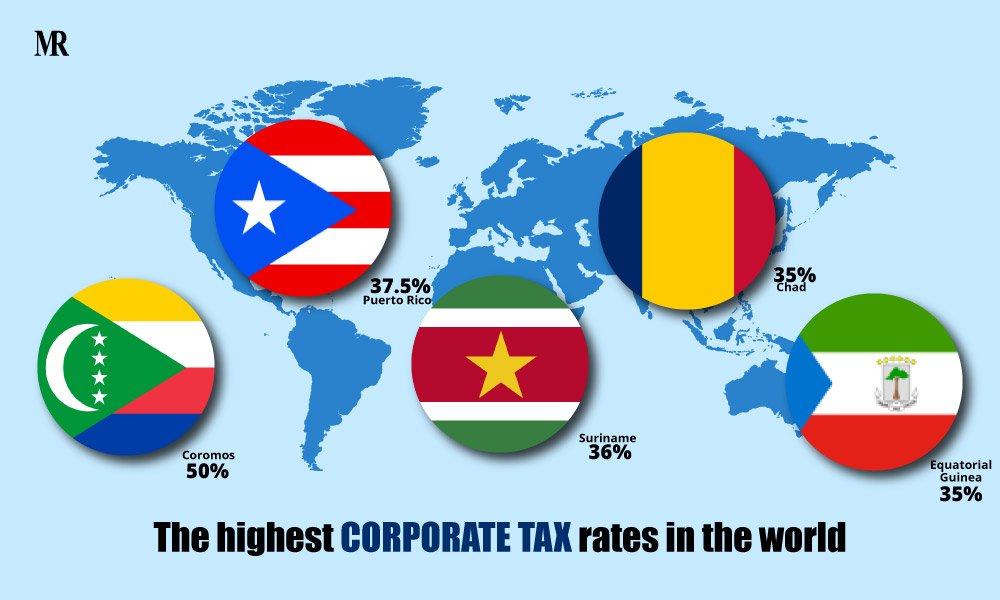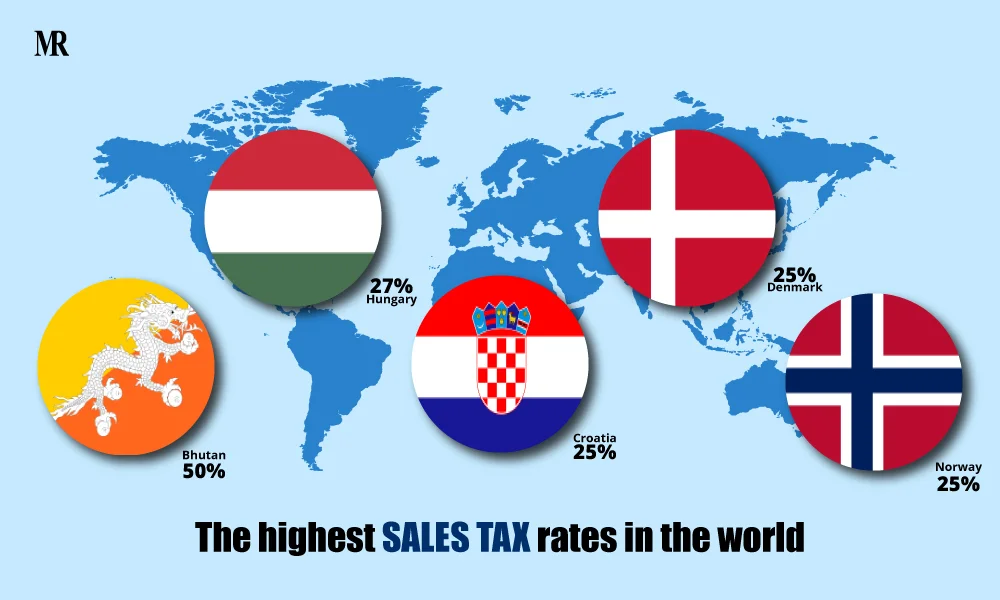TAX —a word that makes your head spin, right!? But have you ever wondered which countries have the highest tax rates in the world and why?
A tax is a mandatory financial charge imposed by a government on individuals, businesses, or other entities to fund public services and infrastructure. Some countries impose higher tax rates to support extensive social welfare programs, healthcare, and education. Others rely on high taxes to boost economic development or balance national budgets.
In this blog, we’ll explore the list of countries with:
- Highest Personal Income Tax Rates In The World
- Highest Corporate Tax Rates In The World
- Highest Sales Tax Rates In The World
So let’s dive into the numbers and see which countries top the list and what makes their tax systems unique.
The highest personal income tax rates in the world

Personal income tax is a tax that is levied on the income of individuals or households, such as wages, salaries, dividends, interest, or capital gains.
Personal income tax rates depend on factors like government revenue needs, income levels, and economic conditions. Many countries use a progressive system, taxing higher incomes at higher rates. Other factors include inflation, social programs, and incentives like deductions or credits.
List Of Countries With Highest Personal Income Tax Rates In The World
| Country | Continent | Personal income tax rate |
| Ivory Coast | West Africa | 60% |
| Finland | Europe | 57.30% |
| Japan | Asia | 55.95% |
| Denmark | Europe | 55% |
| Austria | Europe | 52.30% |
1. Ivory Coast
- Personal Income Tax Rate: 60%
Ivory Coast, or Côte d’Ivoire, has a tax system that includes both direct income taxes and a general income tax (IGR).
Ivory Coast is the most taxed country in the world with a personal income tax rate of 60%. Residents pay a salary tax of 1.5% on 80% of their gross income, with the tax deducted by employers.
The national contribution, which is also 80% of gross income, is taxed at progressive rates ranging from 1.5% to 10%, depending on the income bracket.
Personal income taxes are an important revenue source for the Ivorian government. The country’s economy has been growing, driven by strong exports of cocoa, cashew, coffee, and palm oil, along with emerging oil and gas reserves.
2. Finland
- Personal Income Tax Rate: 57.30%
Finland taxes residents on their worldwide income and has a personal income tax rate of 57.30%.
Earned income received by residents is taxed at progressive tax rates for national tax purposes and at a flat tax rate for municipal (and church and social security) tax purposes.
Finland’s high personal income tax rates are primarily driven by its strong welfare system, which includes healthcare, education, and social benefits.
The progressive tax system ensures wealth distribution and funds public investments in infrastructure and social security.
3. Japan
- Personal Income Tax Rate: 55.95%
Japan’s high personal income tax rates are driven by the need to support its aging population, funding pensions and healthcare services. Japan’s personal income tax rate at 55.95% is the third highest in the world.
In Japan, permanent residents are taxed on their worldwide income, while non-residents are only taxed on income sourced from Japan.
Non-permanent residents are taxed on income other than foreign-source income that is not brought into Japan, as well as on part of their foreign-sourced income if it is paid or remitted to Japan.
Additionally, the progressive tax system and local taxes contribute to the overall tax burden, alongside social security contributions for unemployment and health insurance.
4. Denmark
- Personal Income Tax Rate: 55%
Denmark’s high personal income tax rates are primarily due to its extensive welfare system, which provides universal healthcare, education, and social security benefits.
In Denmark, the personal income tax rate is at 55%, making it one of the countries with highest taxes. Residents are taxed on their worldwide income, while non-residents are taxed only on income from Danish sources.
Taxes include national income tax, municipal tax, labor market tax, and church tax.
Despite these high taxes, many Danes view them as a worthwhile investment, appreciating the quality of public services and the strong social safety net they receive in return.
5. Austria
- Personal Income Tax Rate: 52.30%
In Austria, all residents are taxed on their worldwide income, including earnings from business, employment, investments, and property.
Non-residents are only taxed on income sourced from Austria. They pay taxes on Austrian income at regular rates, with an additional fictitious income increase of EUR 10,888.
There are no local income taxes in Austria.
The highest corporate tax rates in the world

Corporate Tax is a tax imposed on a company’s profits after deducting expenses like salaries, rent, and operational costs. Businesses must pay a percentage of their earnings to the government.
Corporate tax rates are influenced by a country’s tax policies, which are set based on economic goals and revenue needs. They also depend on factors like business size, industry type, available tax incentives, financial conditions, and competition with other countries to attract investments.
List Of Countries With The Highest Corporate Tax Rates In The World
| Country | Continent | Corporate tax rate |
| Coromos | East Africa | 50% |
| Puerto Rico | North America | 37.5% |
| Suriname | South America | 36% |
| Chad | Central Africa | 35% |
| Equatorial Guinea | Central Africa | 35% |
1. Coromos
Corporate tax rate: 50%
The standard corporate tax rate in Comoros is 35%, applicable to both local and foreign companies earning income from Comoros.
However, public industrial and commercial enterprises, or those with state or public institution participation, face a higher corporate tax rate of 50% if their turnover exceeds 500 million Comorian francs.
As a result, Comoros has some of the highest corporate tax rates globally.
2. Puerto Rico
Corporate tax rate: 37.5%
Puerto Rico has the second highest corporate tax rates in the world, reaching up to 37.5%.
Puerto Rico taxes domestic corporations on their worldwide income and foreign corporations on Puerto Rico-source income.
The corporate income tax consists of a regular tax rate and a graduated surtax. There is an alternative minimum tax (AMT) for corporations with high gross income, and deductions for AMT purposes are more limited than for regular tax
A tax is also imposed on deemed dividends for foreign owners holding 50% or more of a corporation’s stock.
Additionally, as a U.S. territory, Peurto Rico is subject to both federal and local tax policies, which can push the overall corporate tax rate higher.
3. Suriname
Corporate tax rate: 36%
Suriname, consistently ranked among the highest taxed countries, faces a prolonged economic downturn, triggered by plummeting commodity prices, notably in oil and gold, which poses threats to business competitiveness.
Additionally, the country depends on corporate taxes to generate revenue for public services, reduce budget deficits, and manage public debt.
4. Chad
Corporate tax rate: 35%
In Chad, corporate tax applies to profits earned from activities within the country.
The corporate tax rate is 35% in Chad, with tax regimes based on turnover.
Chad’s high corporate tax rate is driven by the need for revenue to fund public services and infrastructure. The economy’s dependence on oil and mining sectors also leads to higher taxes on these industries, while the tax system aims to attract foreign investment and ensure adequate public spending.
5. Equatorial Guinea
Corporate tax rate: 35%
Equatorial Guinea’s corporate tax rate is 35%, applicable to taxable profits.
In 2025, the corporate tax rate is set to decrease to 25%, easing the burden on companies.
Additionally, a minimum income tax of 1% of the previous year’s turnover applies, with a minimum of 800,000 Central African CFA francs.
Non-resident entities and individuals are subject to a 10% withholding tax on gross income derived from Equatorial Guinea sources.
These tax rates and policies are designed to generate revenue for the government and attract foreign investment.
The highest sales tax rates in the world

Sales tax is a tax on goods and services, paid by the consumer when they make a purchase. The business collects the tax and sends it to the government.
VAT is similar to sales tax but works differently. It’s an indirect tax, meaning the consumer pays it, but businesses handle the collection. Some goods and services are usually exempt from VAT in different regions.
List Of Countries With Highest Sales Tax Rates In The World
| Country | Continent | Sales tax rate |
| Bhutan | Asia | 50% |
| Hungary | Europe | 27% |
| Croatia | Europe | 25% |
| Denmark | Europe | 25% |
| Norway | Europe | 25% |
1. Bhutan
Sales Tax Rate: 50%
The sales tax rate is 50% in Bhutan, making it the highest in the world.
Bhutan introduced the Sales Tax and Customs Excise Act in 2000, establishing regulations for sales tax, excise duties on goods and services within the country, and customs duties on imports.
The Ministry of Finance determines the applicable rates and schedules. Currently, sales tax serves as Bhutan’s main source of indirect taxation, applied to imported goods and select domestic services, including entertainment and hotel accommodations.
2. Hungary
Sales Tax Rate: 27%
Hungary ranks second in the list of countries with the highest sales tax rate with a sales tax of 27%.
In Hungary, the standard VAT rate applied to the sale of goods and services is 27%. However, certain goods and services qualify for reduced rates of 18% and 5%
3. Croatia
Sales Tax Rate: 25%
Croatia adheres to EU regulations regarding VAT compliance but has the flexibility to determine its own standard VAT rate. The VAT rate in Croatia is currently 25%.
Businesses registered for VAT in Croatia are required to apply the correct rate, collect the tax, and submit it to the Croatian tax authorities through regular VAT filings.
4. Denmark
Sales Tax Rate: 25%
Denmark implemented Value Added Tax (VAT) in 1967, with the current standard rate of 25% established in 1991.
The VAT rate structure in Denmark is governed by the European Union (EU). There is only a single Denmark VAT rate in the Danish VAT system with no reduced VAT rates.
5. Norway
Sales Tax Rate: 25%
Norway’s standard VAT rate is 25%, which applies to most goods and services. There are also reduced rates of 15% and 12%. A super-reduced rate of 11.10% is available for specific items.
Some goods are zero-rated, meaning no VAT is charged, but they must still be reported in the VAT return.
Expert Takeaways
| Key Insights | Examples | Why It Works(or Doesn’t) |
| Scandinavian countries with the highest taxes are ranked among the happiest countries globally. | Denmark, Finland, Sweden | Strong welfare systems, trust in government, work-life balance, and high-quality services. |
| Despite high taxes, certain countries have strong GDPs and economic stability. | Japan, Austria, Finland | Taxes fund infrastructure, education, and innovation, ensuring long-term growth. |
| Low-tax countries attract businesses, while high-tax ones focus on social equality and welfare. | U.S., Norway, Denmark | Low taxes boost entrepreneurship; high taxes ensure stability and public welfare. |
| High taxes result in superior public services in the Scandinavian regions | Norway, Sweden | Citizens see value in paying higher taxes for comprehensive social benefits. |
| Developing Nations with High Taxes Struggle with Economic Growth | Ivory Coast, Chad | Corruption, economic dependence on commodities, and inefficient tax revenue management. |
FAQs
- Which country is 100% tax-free?
Ans: The Bahamas, Panama, Cayman Islands, Dominica, and Bermuda are some countries that are 100% tax-free.
- What are the qualities of a good tax system?
Ans: A good tax system is fair, simple, efficient, transparent, stable, and flexible. A good tax system also generates sufficient revenue for government operations while minimizing the overall burden on the people, maximizing social benefit, and promoting favorable economic growth.
Also Read: Top 10 Highest Currencies in the World You should know about










